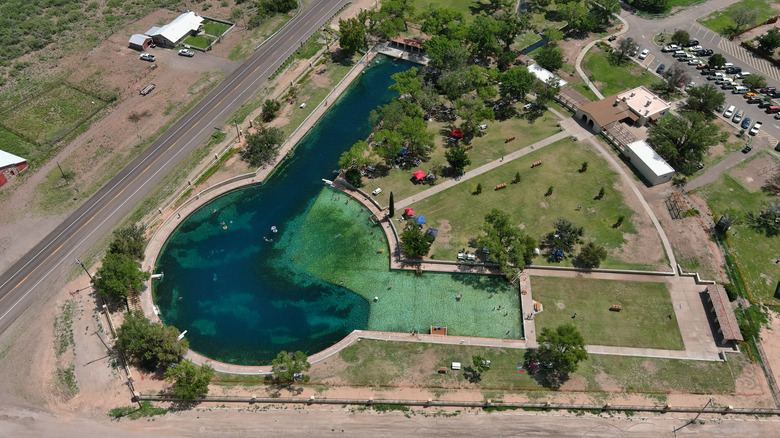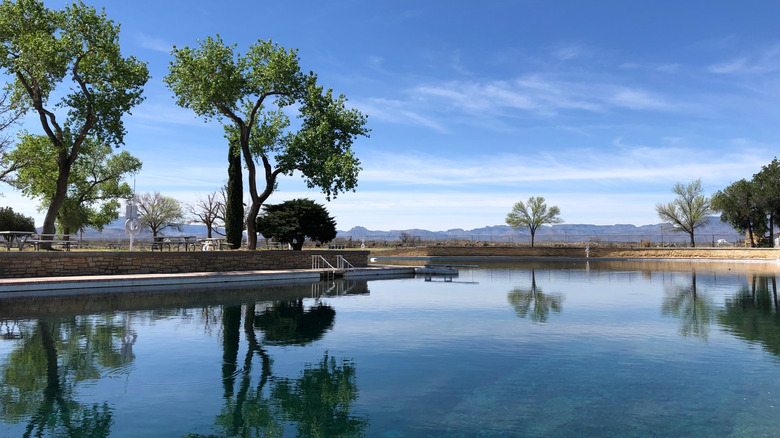The World's Largest Spring-Fed Swimming Pool Is A Natural Wonder Right Here In America
Texas is home to several natural wonders. Multiple types of precious gems can be found there, and there's a stunning diversity of geographic landforms in the Lone Star state, from the canyons of Big Bend country to the Panhandle plains. Then, there's the Texas cave that houses the world's largest bat colony, where more than 15 million Mexican free-tailed bats gather during the summer months. If you fancy something a bit more relaxing than hordes of bats, there's also what might just be the world's largest spring-fed swimming pool.
In the Chihuahuan Desert of west Texas, Balmorhea State Park is home to a 1.3-acre pool fed by the nearby San Solomon Springs. The pool was constructed by the Civilian Conservation Corps back in the 1930s and opened in June 1936. Ever since, it has been a consistent draw for local residents and visitors to the park. Its size, calm waters, and welcoming temperatures provide the perfect place for visitors to swim and even scuba dive or snorkel, making it a truly unique attraction powered by the surrounding natural environment.
Balmorhea is one of the largest spring-fed pools in the world
Back in 1935, 200 members of the Civilian Conservation Corps started quarrying nearby limestone, building two bathhouses, a concession building, and the San Solomon Springs Courts, the on-site motel. The Balmorhea pool opened with a big two-day ceremony in June 1936, commemorating the new addition to the state park with a range of activities from a bathing-girl revue to swimming competitions and speedboat races on nearby Lake Balmorhea.
Balmorhea pool isn't the only spring-fed pool in Texas — Barton Springs Municipal Pool in Austin is also a notable example. But Balmorhea is likely the largest. The freshwater pool covers an area of 1.3 acres and is 25 feet deep in places. It holds 3.5 million gallons of water which remains at a nicely temperate 72 to 76 degrees year-round, the same temperature as the rocks through which the water moves before reaching the pool throughout the year. Balmorhea is 7 feet deeper in places than Barton Springs, but according to Texas Monthly, thus far, the necessary surveys haven't been carried out to determine which body of water is technically bigger.
Situated in the park's northeastern corner, Balmorhea pool is fed by the San Solomon Springs, which provides more than 15 million gallons of water each day. According to the Texas State Parks site, this is enough water to fill more than 300,000 bathtubs every single day. In order to get to the pool, however, that water has to make a long and extraordinary journey.
The water that feeds Balmorhea makes an incredible journey
The water that eventually finds its way to Balmorhea pool comes from a large aquifer system — an area of porous rock or sediment which is saturated with groundwater fed by rain that seeps through the soil — 400 miles northwest of the park. That underground water ultimately pushes its way through the porous limestone and fault lines in the earth before pushing upward and emerging through geologic faults. This makes the San Solomon Springs an artesian spring, which refers to a source of ground water which is forced to the surface by pressure from underground rock layers around the aquifer.
After making this long journey, the water finds its way through the Balmorhea pool then out through the park's cienegas (a type of spring-fed marsh unique to the southwest) and canals, where it provides a home for multiple rare and endangered species including two freshwater springsnails, the diminutive amphipod, and two species of fish unique to west Texas: the Comanche Springs pupfish and the Pecos gambusia. Before the pool was built, the springs emptied into a natural cienega, but this was replaced by the addition of the pool, with builders constructing two man-made cienegas which now support the local wildlife.
Following fundraising efforts which began in 2018 and raised more than $2 million, Balmorhea underwent renovation, which was completed in 2020. Today it welcomes daily visitors, which are capped at 900 — still a considerable amount of people for a spring-fed pool. The site is open from 8 a.m. to 7:30 p.m. (or earlier depending on the time of sunset).


